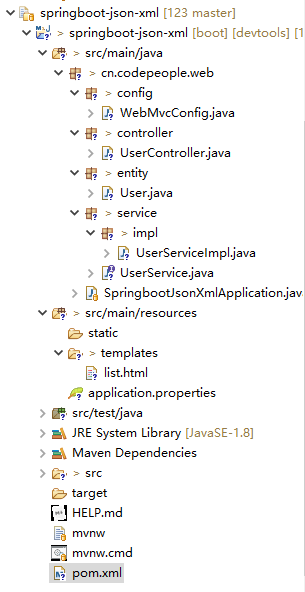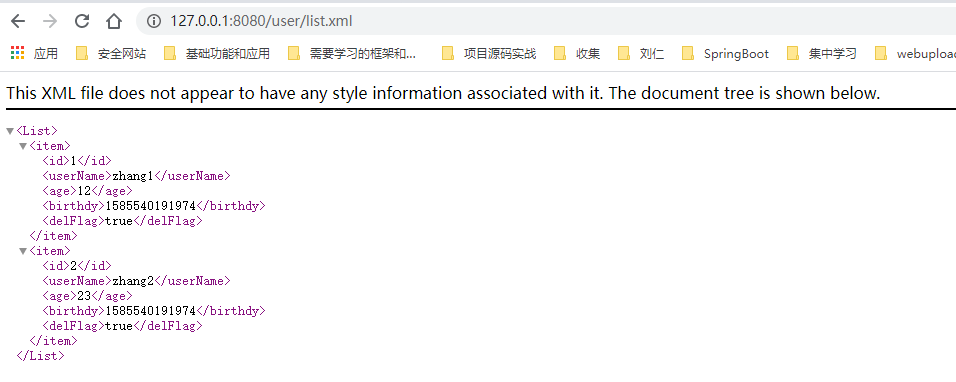Springboot is based on the url suffix Return json or xml; Returns html based on the suffix name. Author: liuren
Copyright notice: This is an original article, following CC 4.0 BY-SA copyright agreement. Please attach the original source link and this notice for reprint.
Initializing the Springboot project
1, pom.xml package introduced first
<?xml version="1.0" encoding="UTF-8"?> <project xmlns="http://maven.apache.org/POM/4.0.0" xmlns:xsi="http://www.w3.org/2001/XMLSchema-instance" xsi:schemaLocation="http://maven.apache.org/POM/4.0.0 https://maven.apache.org/xsd/maven-4.0.0.xsd"> <modelVersion>4.0.0</modelVersion> <parent> <groupId>org.springframework.boot</groupId> <artifactId>spring-boot-starter-parent</artifactId> <version>2.2.4.RELEASE</version> <relativePath/> <!-- lookup parent from repository --> </parent> <groupId>cn.codepeople</groupId> <artifactId>springboot-json-xml</artifactId> <version>0.0.1-SNAPSHOT</version> <name>springboot-json-xml</name> <description>Springboot according to url Suffix return json perhaps xml perhaps html</description> <properties> <java.version>1.8</java.version> </properties> <dependencies> <dependency> <groupId>org.springframework.boot</groupId> <artifactId>spring-boot-starter-thymeleaf</artifactId> </dependency> <dependency> <groupId>org.springframework.boot</groupId> <artifactId>spring-boot-starter-web</artifactId> </dependency> <dependency> <groupId>com.fasterxml.jackson.dataformat</groupId> <artifactId>jackson-dataformat-xml</artifactId> </dependency> <dependency> <groupId>org.springframework.boot</groupId> <artifactId>spring-boot-devtools</artifactId> <scope>runtime</scope> <optional>true</optional> </dependency> <dependency> <groupId>org.springframework.boot</groupId> <artifactId>spring-boot-starter-test</artifactId> <scope>test</scope> <exclusions> <exclusion> <groupId>org.junit.vintage</groupId> <artifactId>junit-vintage-engine</artifactId> </exclusion> </exclusions> </dependency> </dependencies> <build> <plugins> <plugin> <groupId>org.springframework.boot</groupId> <artifactId>spring-boot-maven-plugin</artifactId> </plugin> </plugins> </build> </project>
Project structure chart

Start project configuration
application.properties
spring.thymeleaf.mode=HTML #Suffix name spring.thymeleaf.encoding=utf-8 #Encoding format spring.thymeleaf.cache=false #Use cache or not
Spring boot configuration
WebMvcConfig.java
package cn.codepeople.web.config; import org.springframework.context.annotation.Configuration; import org.springframework.http.MediaType; import org.springframework.web.servlet.config.annotation.ContentNegotiationConfigurer; import org.springframework.web.servlet.config.annotation.WebMvcConfigurationSupport; @Configuration public class WebMvcConfig extends WebMvcConfigurationSupport { @Override protected void configureContentNegotiation(ContentNegotiationConfigurer configurer) { configurer.favorPathExtension(true) //Is suffix supported .parameterName("mediaType") .defaultContentType(MediaType.APPLICATION_JSON) .mediaType("xml", MediaType.APPLICATION_XML) //Return xml data when the suffix name is xml .mediaType("html", MediaType.TEXT_HTML) //Return to the html page when the suffix name is html .mediaType("json", MediaType.APPLICATION_JSON);//Return json data when the suffix name is json } }
New Bean entity class
User.java
package cn.codepeople.web.entity; import java.util.Date; import javax.xml.bind.annotation.XmlRootElement; @XmlRootElement public class User { private Long id; private String userName; private String age; private Date birthdy; private boolean delFlag; public Long getId() { return id; } public void setId(Long id) { this.id = id; } public String getUserName() { return userName; } public void setUserName(String userName) { this.userName = userName; } public String getAge() { return age; } public void setAge(String age) { this.age = age; } public Date getBirthdy() { return birthdy; } public void setBirthdy(Date birthdy) { this.birthdy = birthdy; } public boolean isDelFlag() { return delFlag; } public void setDelFlag(boolean delFlag) { this.delFlag = delFlag; } }
New UserService.java interface
UserService.java
package cn.codepeople.web.service; import java.util.List; import cn.codepeople.web.entity.User; public interface UserService { List<User> listUser(); }
New UserServiceImpl implementation class
UserServiceImpl.java
package cn.codepeople.web.service.impl; import java.util.ArrayList; import java.util.Date; import java.util.List; import org.springframework.stereotype.Service; import cn.codepeople.web.entity.User; import cn.codepeople.web.service.UserService; @Service public class UserServiceImpl implements UserService { @Override public List<User> listUser() { List<User> list = new ArrayList<User>(); User user = new User(); user.setId(1L); user.setAge("12"); user.setDelFlag(true); user.setUserName("zhang1"); user.setBirthdy(new Date()); list.add(user); User userx = new User(); userx.setId(2L); userx.setAge("23"); userx.setDelFlag(true); userx.setUserName("zhang2"); userx.setBirthdy(new Date()); list.add(userx); return list; } }
New controller class
package cn.codepeople.web.controller; import java.util.List; import org.springframework.beans.factory.annotation.Autowired; import org.springframework.stereotype.Controller; import org.springframework.web.bind.annotation.RequestMapping; import org.springframework.web.bind.annotation.ResponseBody; import cn.codepeople.web.entity.User; import cn.codepeople.web.service.UserService; @Controller @RequestMapping("/user") public class UserController { @Autowired private UserService userService; @RequestMapping("/list") @ResponseBody private List<User> listUser(){ return userService.listUser(); } @RequestMapping("/index") public String user() { return "list.html"; } }
Modify SpringbootJsonXmlApplication.java startup class
package cn.codepeople.web; import org.springframework.boot.SpringApplication; import org.springframework.boot.autoconfigure.SpringBootApplication; @SpringBootApplication public class SpringbootJsonXmlApplication { public static void main(String[] args) { SpringApplication.run(SpringbootJsonXmlApplication.class, args); } }
Create a new list.html file in the templates directory
list.html
<!DOCTYPE html> <html> <head> <meta charset="UTF-8"> <title>Insert title here</title> </head> <body> Springboot according to url Suffix return json perhaps xml perhaps html ->>> </body> </html>
Launch success page
The access address is: http://127.0.0.1:8080/user/list.json

The access address is:< http://127.0.0.1:8080/user/list.xml

The access address is:< http://127.0.0.1:8080/user/index.html

I don't understand one thing. If you have a deep understanding, please help me to answer it. The default format in WebMvcConfig.java is json
But if I return the xml format file without suffix, is it because I didn't make the default format configuration in the controller? If no suffix is added, follow the
Should WebMvcConfig.java configuration return json?
Blog address: https://www.codepeople.cn
=====================================================================
The official account of WeChat:
